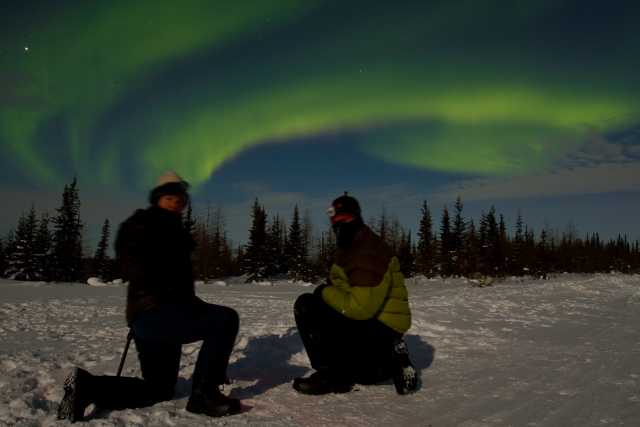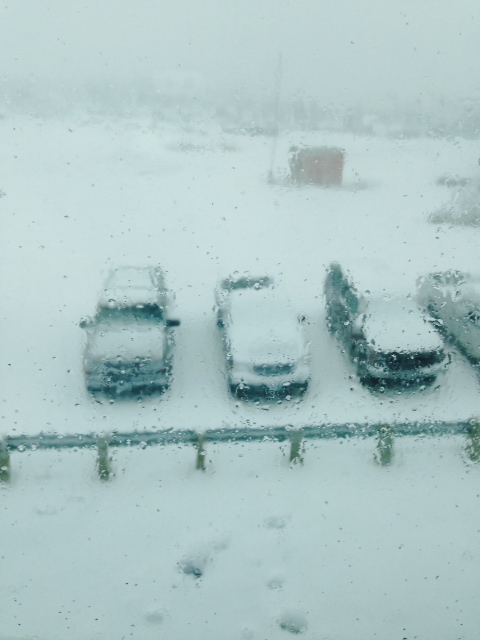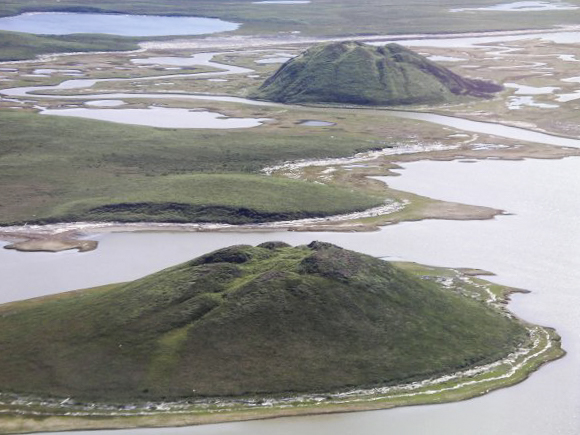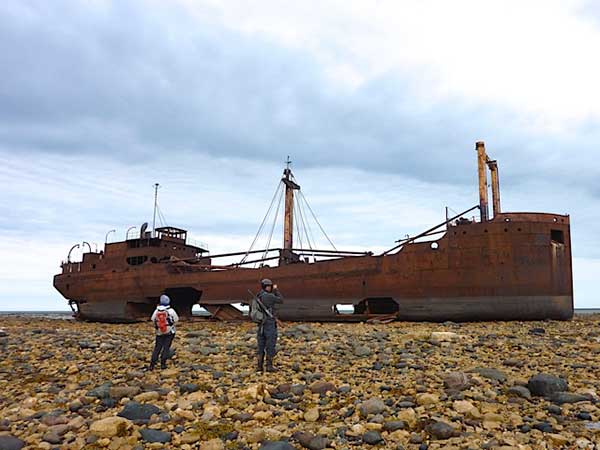by Steve Selden | Jan 20, 2015 | Churchill News
Below freezing temperatures have blown in from the north across the Hudson Bay and settled into the Churchill region lowlands. The snow covered tundra and stunted spruce trees are frosted over and the land has fallen into a deep hibernation for the remainder of winter.
The extended forecast will make most people shiver though in the north they tend to adjust to the cold once it becomes a daily norm. Take a look at the short – term outlook at this Environment Canada website.

Winds and cold temperatures in Churchill. Brad Josephs photo.
With the cold comes general good visibility this time of year. This is the reason, coupled with the higher solar flare activity, that February and March are optimal months for northern lights viewing around the polar regions. In these months the axis of the earth is slightly more aligned with the sun’s axis producing more auroral bands in the region.
The extensive number of clear nights with the occasional winter blizzard make for incredible
northern lights viewing and photography. Extended hours of darkness provide greater opportunities for aurora viewing as well. The snowy landscape enhances the scenes with reflective light. Even half to full moons during these months make for some unique lighting on the landscape and also the chance to get some great photos of the lights and moon together. This is the time to see northern lights in Churchill!

Photography of the northern lights has become a passion in the north. Brad Josephs photo.
Want to see northern lights in Churchill? Check out nathab.com today!
by Steve Selden | Jan 16, 2015 | Churchill News
Those that travel to Churchill, Manitoba, one of the increasingly rare places on Earth, you can “leave it all behind”, as they say, should literally really consider leaving a few things behind. Not just the routine stresses or habits of daily life.

A sun dog casting its’ rays on an inukshuk. Brad Josephs photo.
1. Cell Phone-Although Churchill just upgraded cell service to 4G – high speed, this is a place travelers might refrain from using or even bringing a cell phone. I clearly remember the awful feeling I had after working in Churchill for about 10 years upon hearing cell service was coming to town. The “disconnected” experience, especially in such a pristine and wild frontier town is a dying phenomena. When traveling to a place that you might only visit once in your lifetime, let the mind and soul get the full experience. In such a tight knit community people tend to interact face to face as they often see each other almost every day.
2. Running Shoes- Even the most avid runners might consider taking some time off from this form of exercise in Churchill. Unless you plan to run around the nine or so blocks of town, and get plenty of strange looks, any long distance out-of-town jaunts are discouraged most seasons of the year. Unless you have a friend driving along in a car with you or you can run faster than 35 mph for an extended time. Now you could run in the dead of winter though it’s a bit difficult in eight layers of clothing and sorels.
3. Cats- Believe it or not a Natural Habitat traveler insisted on bringing their cat from California on a trip to Churchill. We made accommodations for the pet but that’s really not the point. Given the number of sled dogs in Churchill and north in general it really can’t be considered “cat country” by any stretch of the imagination.

My excellent room mate Buddy the cat.
4. Too Much Camera Equipment- While Churchill is one of the most diverse and inspiring places in North America to photograph or video wildlife and landscapes, someone who travels to Churchill seeking a fully immersed experience might consider scaling back, taking in the live experience and letting the mind store lifetime memory images. Now, serious or professional photographers will have a slightly different opinion but they tend to have mastered the ability to enjoy both aspects of the craft..enjoying the moment while getting their shots or footage. I have guided many summer beluga whale trips where some folks spent too much time and energy trying to get the one-in-a-million poster-shot and miss the amazing full immersion of the adventure. This theory translates to polar bear season as well. There’s definitely an aura that exists in these far reaching places that one cannot translate through a lens.

Natural Habitat travelers swimming in the Churchill River. Steve Selden photo.
5. Bathing Suit- The town complex does have an indoor pool thought the hours of operation are a little spotty. Unless you’re planning on taking a polar bear plunge in the 40 C Hudson Bay, which on certain summer “hotspot of Manitoba” days could be an option. You might also want to jump in the Churchill River ( more like 50-55 C down – river a bit), which I have done numerous times. So, actually want to bring a bathing suit and which retrospectively makes this post Four Things You Don’t Need In Churchill. We will leave this last one up to you. Skinny dipping is always an option.
by Steve Selden | Jan 14, 2015 | Churchill News
The first winter I spent on Cape Cod the Cumberland Farms convenience store ran out of milk in the middle of a two day snowstorm. I was in awe that a store in a developed, though somewhat remote, area could run out of such a basic life staple. Churchill, a very remote location by most standards, had a slightly bigger problem …no gasoline for three days.

A look outside the Churchill Northern Studies Center. Donna Kelber photo.
Details of the “shortage” are somewhat sketchy. At what was first construed as a gas shortage was later confirmed by Mayor Mike Spence as a “interruption in service” between town and the 50 million liter tank farm which is only seven kilometers outside of town adjacent to the Port of Churchill. Both facilities are owned by Omnitrax company out of Denver, CO.
Taxi’s were forced to shut down and town vehicles were being garaged and saved for only emergency usage. The town’s only gas station remained closed for the three days.
Petrol service has since been restored and Mayor Spence has vowed that the issue won’t arise again. He and the town are working with Omnitrax to insure service workers will be available to transport fuel from the storage tanks to the gas station.

Port of Churchill with four fuel tanks in the background.
In a location where weather conditions are extreme on a fairly regular basis, the inability to travel across town to the grocery store, work or hospital becomes vital. Even though Churchill is tiny compared to other towns in the world, the winter conditions make a short 10 minute walk across town feel like traveling cross-country.
Keeping out of the political side of this mishap, it serves as an example of how precious fuel resources in the world are and how we all should treat them as such. Most of us do not think twice about being able to drive five minutes and fill our car’s gas tank. If we all had to experience life without fuel for three days it might serve as an excellent reminder of how valuable these resources are. Maybe reassessing trips we all make in our automobiles should be a goal for this year ahead.
by Steve Selden | Jan 11, 2015 | Churchill News
A pingo is a mound of earth-covered ice found in the Arctic and sub Arctic reaching up to 70 meters high and up to 900 meters in diameter. A pingo is a periglacial land form, or a form of patterned ground that is a characteristic of colder climates such as the Arctic or sub-Arctic. The term originates from the Inuvialuktun word for a small hill.

Periglacial is a term used to characterize an environment located on the margin of former glacially active territory. Most of these regions now have layers of permafrost beneath the the top layer of soil. However, freeze and thaw cycles can influence landscapes outside areas of past glaciation. Periglacial environments are regions where freezing and thawing alter the landscape significantly.

Pingo locations in the Canadian Arctic.
They are essentially formed by ground ice which forms during the winter when temperatures dip below the freezing point. When ground water seeps into cracks in the ground it freezes and creates “lenses” of ice which slowly increase in mass as more and more water trickles in. As they grow larger in sizes, the ground above rises from the source forcing the ground to form huge domes. Pingos can be 50-metres high and 900-metres wide. In some, the ice lens has melted and the dome has collapsed into a volcano-shaped hill.plural form is “pingos”.

by Steve Selden | Jan 9, 2015 | Churchill News
Eskimo kissing as we know it in western culture never really happens the way it’s depicted in movies or media. The myth of Inuit or Eskimo’s kissing by touching nose to nose as a romantic gesture is only myth. The gesture is based loosely on a traditional Inuit greeting called a kunik. The Hudson Bay coast north of Churchill is predominately Inuit.

A kunik is a way of expressing affection, usually between loved ones and family members, involving pressing the nose and upper lip against the loved ones’ skin (often the forehead or cheeks ) and breathing in, causing the loved one’s skin or hair to be suctioned close to the nose and upper lip.
This practice morphed into the myth that Inuit “kissed” this way to prevent their mouths from freezing together. Nanook of the North, the infamous 1922 documentary of Inuit life in the northern regions may have spurred the myth by depicting such behavior in the film. The gesture, in actuality, is a non-erotic greeting between Inuit that often have only noses and eyes exposed due to the severity of the cold weather in the northern region.

Would you give a polar bear an Eskimo kiss? Brad Josephs photo.
Yes Inuits kiss on the lips just like most other people in the world. With all the flu viruses circulating around the west, especially in wintertime, maybe we all should adopt the kunik during those contagious times.
Hope you enjoy this northern culture video from Blick Van Glory. Eskimo Love Song is their second music video that was produced in 2008.
by Steve Selden | Jan 7, 2015 | Churchill News
If you have been to Churchill you have more than likely seen the infamous Ithaca shipwreck just off the coast heading toward the airport or polar rover launch-site. The ship rests on the sea-bed 12 miles east of Churchill in Bird Cove.
Built in Three – Rivers, Quebec the Ithaca is eighty meters in length. Operated by the Clarke Steamship Company to deliver nickel concentrate from the works at Rankin Inlet, she sailed from Churchill on 10 September 1960 to collect her cargo, carrying supplies for the settlement. The ship’s rudder fractured in an 80 mph gale force wind and when anchors failed to hold she ran aground on September 14, 1960. The vessel came to rest on the rocky shoals, where it sits today, and all 37 men aboard were rescued.

MV Ithaca (September 2012)
Source: Heidi den Haan
Low tide often allows locals and travelers to walk out to the wreck and gain a close-up vantage point of the rusty behemoth. You will need to keep an eye on the tide chart however as you might end booked in a “rustic” cabin heading nowhere fast. It has happened.
There’s a bit more history of the Ithaca but this is the main crux of the wreck. It stands in the Hudson Bay as a monument to all those seamen that have traveled the waters of the north.















